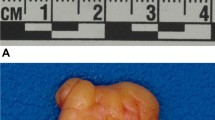Abstract
Objective
To identify the characteristic magnetic resonance imaging (MRI) findings in angioleiomyoma and to clarify its relationship with histopathological findings.
Materials and methods
We retrospectively analyzed the MRI findings and pathological subtypes in 25 patients with subcutaneous angioleiomyoma of the extremities. Based on the previous reports, MRI findings that could be characteristic of angioleiomyoma were extracted. According to the World Health Organization classification, all cases were classified into three pathological subtypes: solid, venous, and cavernous. The relationship between MRI findings and pathological subtypes was analyzed.
Results
The pathological subtypes were solid (n = 10), venous (n = 11), and cavernous (n = 4). The following MRI findings were observed: (a) hypo- or iso-intense linear and/or branching structures on a T2-weighted image (positive total/solid/venous/cavernous: 19/5/10/4, respectively), which we defined as “dark reticular sign”; (b) peripheral hypointense rim on a T2-weighted image (positive total/solid/venous/cavernous: 19/7/8/4, respectively); and (c) presence of any adjacent vascular structures (positive total/solid/venous/cavernous: 6/3/3/0, respectively). Chi-square test showed a significant relationship between dark reticular sign and pathological subtypes (p = 0.0426). The dark reticular sign was found more frequently in the venous and cavernous types than in the solid type. The other MRI findings did not reveal a significant relationship between pathological subtypes.
Conclusion
We present the largest case series exploring MRI findings in angioleiomyoma. The dark reticular sign was a characteristic MRI finding of angioleiomyoma and was seen in most of the venous and cavernous types, which may facilitate preoperative diagnosis.




Similar content being viewed by others
References
Stout AP. Solitary Cutaneous and Subcutaneous Leiomyoma. Am J Cancer. 1937;29(3):435–69.
Matsuyama A. Angioleiomyoma. In: Board tWCoTE, ed. WHO Classification of Tumours Editorial Board Soft tissue and bone tumours. Soft tissue tumours. 3. 5th ed. Lyon (France): World Health Organization; 2020. p. 186–7.
Hachisuga T, Hashimoto H, Enjoji M. Angioleiomyoma. A clinicopathologic reappraisal of 562 cases. Cancer. 1984;54(1):126–30.
Morimoto N. Angiomyoma (vascular leiomyoma): a clinicopathologic study. Med J Kagoshima Univ. 1973;24:663–88.
Hwang JW, Ahn JM, Kang HS, Suh JS, Kim SM, Seo JW. Vascular leiomyoma of an extremity: MR imaging-pathology correlation. AJR Am J Roentgenol. 1998;171(4):981–5.
Yoo HJ, Choi JA, Chung JH, et al. Angioleiomyoma in soft tissue of extremities: MRI findings. AJR Am J Roentgenol. 2009;192(6):W291–4.
Sayit E, Sayit AT, Zan E, Bakirtas M, Akpinar H, Gunbey HP. Vascular leiomyoma of an extremity: report of two cases with MRI and histopathologic correlation. J Clin Orthop Trauma. 2014;5(2):110–4.
Kang BS, Shim HS, Kim JH, et al. Angioleiomyoma of the Extremities: findings on ultrasonography and magnetic resonance imaging. J Ultrasound Med. 2019;38(5):1201–8.
Gupte C, Butt SH, Tirabosco R, Saifuddin A. Angioleiomyoma: magnetic resonance imaging features in ten cases. Skeletal Radiol. 2008;37(11):1003–9.
Klumpp R, Compagnoni R, Patelli G, Trevisan CL. Angioleiomyoma in the posterior knee: a case report and literature review. Knee. 2017;24(3):675–9.
Ramesh P, Annapureddy SR, Khan F, Sutaria PD. Angioleiomyoma: a clinical, pathological and radiological review. Int J Clin Pract. 2004;58(6):587–91.
Kumar S, Hasan R, Maddukuri SB, Mathew M. Angiomyoma presenting as a painful subcutaneous mass: a diagnostic challenge. BMJ Case Rep. 2014;2014:bcr2014206606.
Jin Q, Lu H. Angioleiomyoma of the hand with nerve compression. J Int Med Res. 2020;48(6):300060520928683.
Kinoshita T, Ishii K, Abe Y, Naganuma H. Angiomyoma of the lower extremity: MR findings. Skeletal Radiol. 1997;26(7):443–5.
Blacksin MF, Ha DH, Hameed M, Aisner S. Superficial soft-tissue masses of the extremities. Radiographics. 2006;26(5):1289–304.
Zhang J, Li Y, Zhao Y, Qiao J. CT and MRI of superficial solid tumors. Quant Imaging Med Surg. 2018;8(2):232–51.
Smith J, Wisniewski SJ, Lee RA. Sonographic and clinical features of angioleiomyoma presenting as a painful Achilles tendon mass. J Ultrasound Med. 2006;25(10):1365–8.
Bermejo A, De Bustamante TD, Martinez A, Carrera R, Zabía E, Manjón P. MR imaging in the evaluation of cystic-appearing soft-tissue masses of the extremities. Radiographics. 2013;33(3):833–55.
Acknowledgements
We would like to thank Editage (http://www.editage.com) for editing this manuscript for English language.
Author information
Authors and Affiliations
Contributions
Hiromi Edo and Hiroshi Shinmoto were involved in study design, acquisition of data, analysis and interpretation of data, and drafting the manuscript. Ayano Matsunaga and Susumu Matsukuma were involved in acquisition of data, analysis and interpretation of data, and drafting the manuscript. Ayako Mikoshi was involved in analysis and interpretation of data and drafting the manuscript. Michiro Susa and Keisuke Horiuchi were involved in data collection and drafting the manuscript. All authors read and approved the final manuscript.
Corresponding author
Ethics declarations
Ethical approval
All procedures performed in studies involving human participants were in accordance with the ethical standards of the institutional and/or national research committee and with the 1964 Helsinki declaration and its later amendments or comparable ethical standards. This study was approved by the institutional ethics committee (4302).
Informed consent
Approval from the Institutional Review Board was obtained, and in keeping with the policies for a retrospective review, informed consent was not required. In addition, the patient’s records were anonymously analyzed.
Additional information
Publisher's note
Springer Nature remains neutral with regard to jurisdictional claims in published maps and institutional affiliations.
Rights and permissions
About this article
Cite this article
Edo, H., Matsunaga, A., Matsukuma, S. et al. Angioleiomyoma of the extremities: correlation of magnetic resonance imaging with histopathological findings in 25 cases. Skeletal Radiol 51, 837–848 (2022). https://doi.org/10.1007/s00256-021-03888-4
Received:
Revised:
Accepted:
Published:
Issue Date:
DOI: https://doi.org/10.1007/s00256-021-03888-4




